Tecumseh Starter 37000 Repair: Your Ultimate 2025 Fix-It Guide
You press the button for the electric start on your snow blower, expecting the roar of the engine, but instead, you get a click, a whine, or absolute silence. That Tecumseh 37000 starter, a workhorse on countless machines, has finally given up. It’s a moment of pure frustration, especially with a driveway full of snow.
Before you resign yourself to exhausting pull-starts or spending a small fortune on a replacement, understand that repairing this starter is often simpler than you think. Many failures stem from a few common, correctable issues that require more attention to detail than specialized tools. This guide will walk you through diagnosing and fixing the most frequent problems.
You'll Learn About
Why Your Tecumseh 37000 Starter is Failing (It’s Not What You Think)
While complete motor burnout can happen, it’s often a less dramatic culprit causing the failure. The vast majority of Tecumseh 37000 starter issues trace back to the Bendix drive—the small gear assembly that slides out to engage the engine’s flywheel. Over time, its lubrication becomes a liability.
The original grease applied at the factory hardens and thickens, especially in the cold temperatures these machines operate in. This thickened grease, combined with accumulated dust and light corrosion, creates just enough friction to prevent the Bendix gear from sliding freely along its spiral-cut shaft. The motor spins, but the gear doesn’t move forward to engage, resulting in that tell-tale whirring or grinding sound.
The Deeper Mechanical and Electrical Issues
Beyond a sticky Bendix, other components are prone to wear and tear. The internal carbon brushes, which conduct electricity to the spinning armature, wear down over time. Once they become too short to make solid contact, the starter will seem completely dead.
Electrical connections can also be a source of trouble. Vibration from the engine can loosen mounting bolts, leading to a poor ground connection and intermittent operation. A faulty starter switch or frayed wiring can also interrupt the power needed to turn the motor with enough torque.
Essential Tools and Safety Precautions
A successful repair starts with the right tools and a focus on safety. Before beginning any work, always disconnect the spark plug wire to prevent any chance of the engine accidentally starting. Gather your tools beforehand to ensure a smooth workflow.
Many of the necessary tools are common in a well-equipped garage. A solid set of sockets and wrenches, screwdrivers, and pliers are fundamental. A multimeter will also be invaluable for testing electrical continuity and diagnosing issues beyond simple mechanical failures.
| Tool | Primary Use for Tecumseh 37000 Repair |
|---|---|
| Socket/Wrench Set | Removing the starter mounting bolts and disassembling the starter housing. |
| Pliers (Needle-Nose & Vise-Grips) | Removing and reinstalling the Bendix retaining ring. |
| Multimeter | Testing the starter switch and checking for electrical continuity within the motor. |
| Brass Wire Brush | Cleaning corrosion from the Bendix shaft and armature commutator. |
| Dry Lubricant (Graphite or Teflon Spray) | Lubricating the Bendix drive shaft after cleaning. Do not use heavy grease. |
| Contact Cleaner | Cleaning electrical connections and the brush housing. |
Step-by-Step Starter Removal and Bench Testing
First, gain clear access to the starter motor. On many snow blowers, this may require removing a protective cover or shroud. The Tecumseh 37000 is typically held in place by two or four bolts connecting it to the engine block.
Note that the top mounting points often use shoulder bolts and are slotted, meaning you may only need to loosen them, not fully remove them, to slide the starter out after the bottom bolts are removed. Once the starter is free from the engine, you can perform a definitive bench test to confirm the problem.
The Ultimate Bench Test
With the starter on a workbench, you can safely apply power to diagnose its behavior. Use an extension cord to connect to the starter’s plug. When you press the starter button, observe the Bendix gear closely. Does it spin but fail to shoot forward? Does it not spin at all? This test isolates the starter from any other machine-related issues.
A starter that spins freely but doesn’t engage the flywheel almost certainly has a Bendix issue. If you face a no-spark condition alongside starting troubles, the problem could be more complex, potentially involving the ignition system. You might want to investigate the Tecumseh coil under the flywheel in such cases.

Fixing the Most Common Problems
With the starter on your bench and the issue diagnosed, you can now proceed with the specific repair. Most fixes fall into one of three categories: a stuck Bendix, worn brushes, or faulty electrical connections.
Repair Guide #1: The Whirring Starter (Bendix Gear Service)
This is the most common failure mode. The key to this repair is meticulous cleaning and the correct type of lubrication. To access the Bendix, you must remove the soft metal retaining ring at the end of the shaft. This can often be done carefully with pliers and a small screwdriver.
Once the ring is off, the gear, spring, and washers slide off the shaft. Use a brass wire brush and a solvent like brake cleaner to scrub the spiral grooves on the shaft and the inside of the gear assembly. Remove every trace of old, hardened grease and any surface rust. The goal is to have clean, bare metal.
After cleaning, apply a dry lubricant. A spray-on graphite or Teflon lubricant is ideal because it provides lubrication without attracting dust or thickening in the cold. Reassemble the Bendix components and test its movement by hand; it should slide smoothly and snap back under spring tension.
Repair Guide #2: The Dead Starter (Brush Replacement)
If the starter makes no sound or just hums, the issue is likely internal and often points to the brushes. To access them, remove the two long case bolts that hold the end cap on. As you carefully pull the housing apart, be prepared for the four spring-loaded brushes to pop out of their holders.
Inspect the carbon brushes. If they are worn down to a few millimeters in length or are chipped, they need replacement. The commutator—the segmented copper part of the armature the brushes contact—should also be cleaned with fine-grit sandpaper or a contact cleaner to remove carbon buildup.
Installing new brushes can be tricky. A common technique is to use small clamps or picks to hold each brush in its holder while you slide the armature back into place. Ensure each brush makes firm contact with the commutator before closing up the housing.
Repair Guide #3: The Clicking or Intermittent Starter (Electrical Faults)
A clicking sound often indicates that power is reaching the starter but isn’t enough to turn the motor, which can be due to a poor connection. Check that the starter’s mounting bolts are tight, as they provide the ground path. Clean the mounting surfaces on both the starter and the engine block.
Use a multimeter to check the starter switch for continuity when the button is pressed. A faulty switch can prevent a complete circuit. Also, inspect the power cord for any visible damage or frayed wires that could cause a short or an open circuit.
Reassembly, Installation, and Final Testing
Once the repair is complete, reassemble the starter, ensuring the case bolts are tightened evenly. Before mounting it back on the engine, perform one final bench test to confirm that it spins and the Bendix engages correctly.
When reinstalling, apply a drop of thread locker to the mounting bolts to prevent them from vibrating loose over time. Ensure the starter gear properly meshes with the flywheel; there should be minimal play. Once everything is secure, reconnect the spark plug wire and test the electric start. This same starter is often found on various machines, from a classic Jacobsen Imperial 826 to more modern units.
Knowing When to Replace Instead of Repair
While most issues are repairable, there are times when a replacement is the more practical option. If you open the motor case and detect a strong burnt smell or see blackened, melted windings on the armature, the motor is likely shorted and beyond simple repair. Significant damage to the starter housing or broken mounting brackets also warrants a new unit.
Consider the cost of parts versus a new starter. If you need to replace both the brush assembly and the Bendix drive, the total cost may approach that of a complete aftermarket starter. Machines like an older MTD 524 snowblower can have a long life, and investing in a new starter can be a worthwhile upgrade.
Proactive Care: How to Make Your Starter Last
A little preventative maintenance can significantly extend the life of your Tecumseh 37000 starter. Periodically, especially before the winter season, run the electric starter for a few seconds. This simple act keeps the Bendix from seizing up due to inactivity and corrosion.
Another crucial tip is to avoid prolonged cranking. If the engine doesn’t start within 5-7 seconds, release the button. Holding it down for extended periods can overheat the starter’s windings, leading to the burnout that requires a full replacement. A non-starting engine is usually a fuel or spark issue, not a starter problem.

